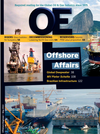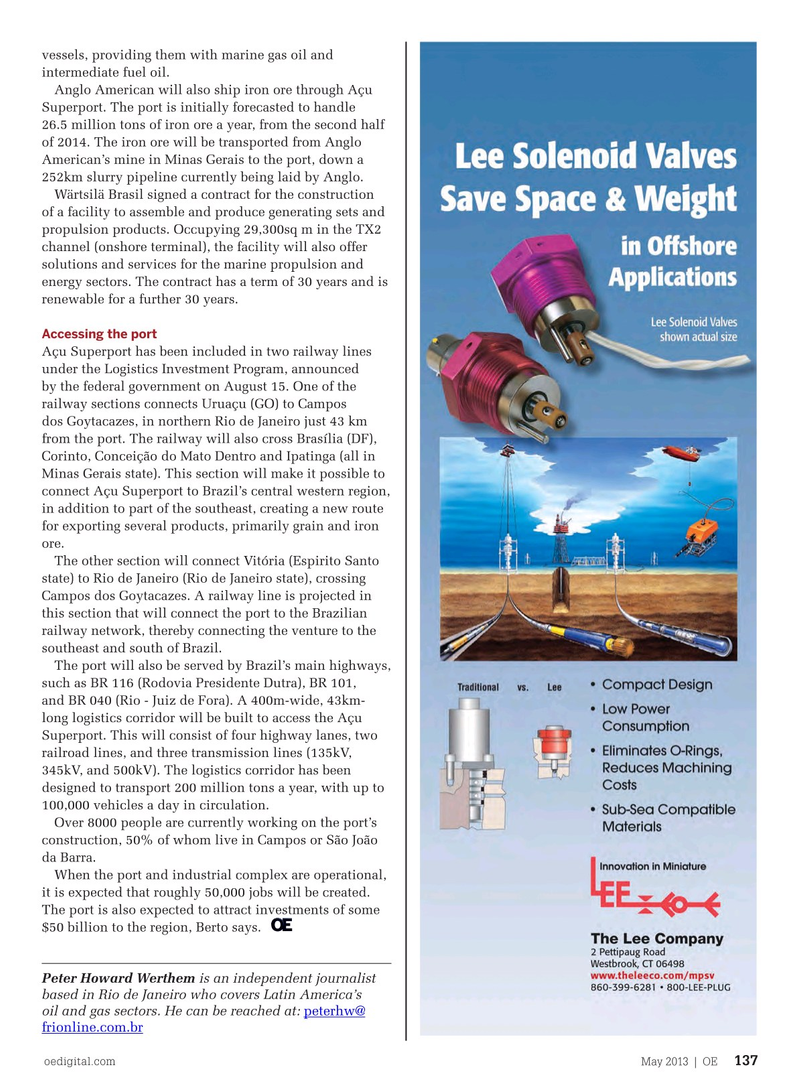
Page 135: of Offshore Engineer Magazine (May/Jun 2013)
Read this page in Pdf, Flash or Html5 edition of May/Jun 2013 Offshore Engineer Magazine
vessels, providing them with marine gas oil and intermediate fuel oil.
Anglo American will also ship iron ore through Açu
Superport. The port is initially forecasted to handle 26.5 million tons of iron ore a year, from the second half of 2014. The iron ore will be transported from Anglo
American’s mine in Minas Gerais to the port, down a 252km slurry pipeline currently being laid by Anglo.
Wärtsilä Brasil signed a contract for the construction of a facility to assemble and produce generating sets and propulsion products. Occupying 29,300sq m in the TX2 channel (onshore terminal), the facility will also offer solutions and services for the marine propulsion and energy sectors. The contract has a term of 30 years and is renewable for a further 30 years.
Accessing the port
Açu Superport has been included in two railway lines under the Logistics Investment Program, announced by the federal government on August 15. One of the railway sections connects Uruaçu (GO) to Campos dos Goytacazes, in northern Rio de Janeiro just 43 km from the port. The railway will also cross Brasília (DF),
Corinto, Conceição do Mato Dentro and Ipatinga (all in
Minas Gerais state). This section will make it possible to connect Açu Superport to Brazil’s central western region, in addition to part of the southeast, creating a new route for exporting several products, primarily grain and iron ore.
The other section will connect Vitória (Espirito Santo state) to Rio de Janeiro (Rio de Janeiro state), crossing
Campos dos Goytacazes. A railway line is projected in this section that will connect the port to the Brazilian railway network, thereby connecting the venture to the southeast and south of Brazil.
The port will also be served by Brazil’s main highways, such as BR 116 (Rodovia Presidente Dutra), BR 101, and BR 040 (Rio - Juiz de Fora). A 400m-wide, 43km- long logistics corridor will be built to access the Açu
Superport. This will consist of four highway lanes, two railroad lines, and three transmission lines (135kV, 345kV, and 500kV). The logistics corridor has been designed to transport 200 million tons a year, with up to 100,000 vehicles a day in circulation.
Over 8000 people are currently working on the port’s construction, 50% of whom live in Campos or São João da Barra.
When the port and industrial complex are operational, it is expected that roughly 50,000 jobs will be created.
The port is also expected to attract investments of some $50 billion to the region, Berto says.
Peter Howard Werthem is an independent journalist based in Rio de Janeiro who covers Latin America’s oil and gas sectors. He can be reached at: peterhw@ frionline.com.br oedigital.com May 2013 | OE 137
Brazil2.indd 137 4/22/13 7:53 PM

 134
134

 136
136